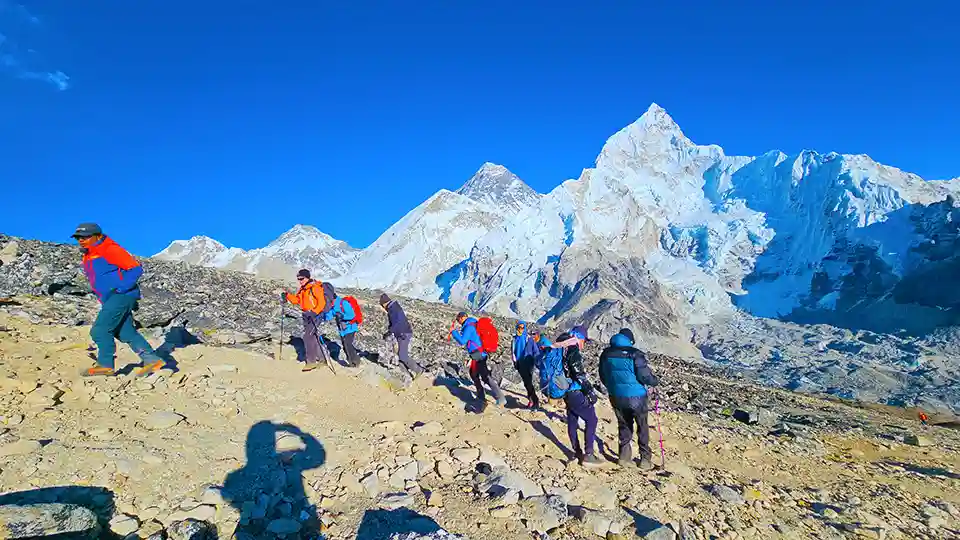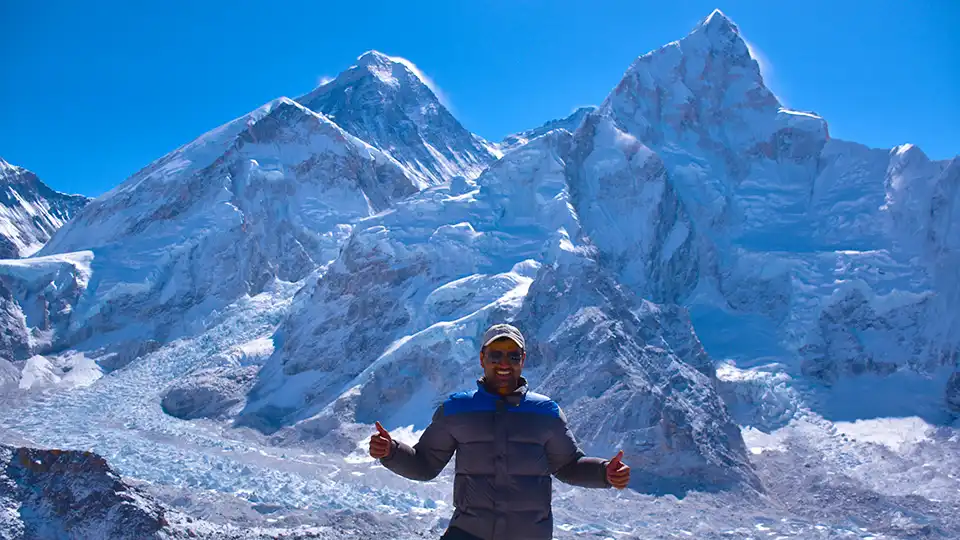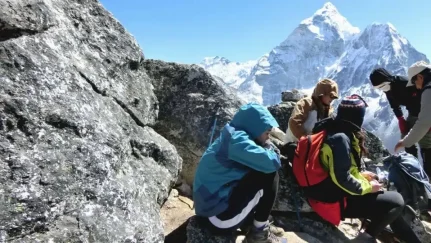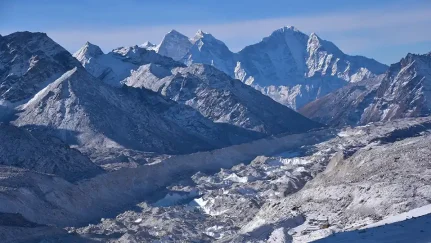Eager trekkers can experience the amazing views in the Everest region stepping from Gorakshep to Kalapatthar. At a distance of about three hours on average from Gorakshep, the trek to Kalapatthar is slightly strenuous but quite rewarding. The trail gained consistently and as you proceed the altitude increases and the Big air becomes thinner thus making each step a little stressful.
Some portions of them are physically challenging because the path is filled with rocks and sometimes there is a cover of snow, however, the beauty of the views assures you you have done the right thing. During the trekking, the trail goes through occasionally large rocks with narrow stretches and only the great north face of Mount Everest emerges in the distance. The last ascent to the peak of Kalapatthar is at 5,643 meters and it involves steep climbing, however, the view at the top is rewarding.
To reach the summit, one can get a panoramic view of the Himalayan giants consisting of Mount Everest, Lhotse, Nuptse, and the various glaciers at the east. The feeling of success and the stunning views are the main rewards that majestic Kalapatthar make the walk to this point one of the most exciting moments of the Everest trek. This is the ideal time and place to stop pulling away to give your eyes a view of the gigantic mountains before descending.
Best Season for Gorakshep to Kalapatthar Trek:
The optimal time for the Kalapatthar trek is from March to April and then October to November. The best time to visit would be mid-April to mid-June or mid-September to mid-November for the best climate.
The temperatures are usually moderate and the sky is clear during spring, therefore trekking is the most appropriate activity to undertake during this season. Normally the outlooks of the Everest and other peaks are great; the tracks are not so wet. This season is also when it is easier to take control of the snow as well.
- Pumori Mountain from Kalapatthar
Similarly, autumn is ideal for the trek as there is a clear sky with cool temperatures that make the trekking enjoyable. The skies are generally clear during this time allowing for a clear view of the Himalayan snow-capped mountains. It is less likely for snow to fall in autumn or for an avalanche to occur compared to winter; the trails are not very busy like in spring, which adds to the quietness.
The best time to trek is from November to May but one has to stay away from the monsoon season because the rains bring about landslides and slippery trails. Another disadvantage of the hike is that during winter, particularly from December to February, there is severe cold, snow, and ice which one is likely to encounter and these do not make the hike enjoyable. Selecting the right time makes the voyage safer and more enjoyable while approaching Kalapatthar.
What time i can start from Gorakshep for Kalapatthar sunrise?
If you want to witness the sunrise here at Kalapatthar you need to get up early and start your trek from Gorakshep. The sunlight in the Everest area starts at 6:00 to 6:30 am, but due to the tough interval and the need to be before dawn at the pinnacle, the climb needs to start at 3:00 am to 3;30am This is because the hike is steep, with numerous sharp rocks that might exert an effect on climbers.
The duration taken to trek from Gorakshep to Kalapatthar is about 2 hours to 2.5 hours depending on the walking speed, the difficulty level of the forest trail, and the hiker’s acclimatization level. The positive thing about walking in the dark here is easy as the place is at a very high altitude, in addition, the early start also assists in avoiding the clouds in the afternoon that may hinder the view.
Updated lists of essentials include headlamps, warm garments, and sufficient water supplies. It gets very chilly sometimes, so be sure to layer up if you wish to avoid freezing to death. Therefore, the hard work of an early start pays dividends as you behold the panoramic view of Everest and other mountains that surround them painted with the natural light of the sun rising on the horizon.
Is really tough to hike Kalapatthar from Gorakshep?
- Gorakshep to Kalapatthar Hike Difficulty
Trekking from Gorakshep to Kalapatthar could be tiring due to the elevated geographical location and tough trails. The trail climbs right from Gorakshep which is more or less 5,164 meters ( 16,942 feet) above sea level. At a higher level, there is less air which makes it difficult to breathe than at the lower levels and one gets easily tired.
The path is often bumpy and filled with stones and in winter the place can be covered with ice and frost. These circumstances can create instability on the feet and it may be challenging to move around safely. It also helps that cold temperatures and wind increase at higher altitudes.
Nevertheless, the hike is quite manageable especially if one prepares adequately, and has adequately acclimatized to high altitude conditions. Undoubtedly, the majority of trekkers complete it successfully if they are physically fit and if they spend enough amount of time at Gorakshep or nearby areas for proper acclimatization. It is also important to go slow, drink enough water, and put on several clothes to negotiate the cold.
Although this section is quite challenging, it offers spectacular scenery of Mount Everest, Lhotse, and other mighty mountains. Pride and satisfaction felt on reaching the top of Kala Patthar along with the panoramic view of the mountains is rewarding for those who are willing and have stamina for it.
weather and temperature at Kalapatthar in 4 seasons:
Gorakshep to Kalapatthar morning hike in Spring (March to May):
Relative to winter months, the temperatures in Kalapatthar slowly increase in the spring months of March and April and range from -15°C to 5°C (5°F to 41°F). Although the climate is relatively warmer in the early part of spring, there may be still snow around until the middle of spring. Nevertheless, with time, mostly in the middle of the summer rainfall decreases, the snow begins to melt, and the skies are clear with a view of Mount Everest. The temperatures are still low, and though it is cold during the day trekking conditions are more favorable in the month of May when the snow and ice are likely to have melted.
Gorakshep to Kalapatthar hikes in Summer (June to August):
Summer in Kala Patthar is the monsoon season. This place is best for a cold climate since its daytime temperature slightly vary between 0 degrees Celsius and 8 degrees Celsius or 32 degrees Fahrenheit to 46 degrees Fahrenheit. Luckily, the weather is relatively warm though the area has continued to receive precipitation, and frequently, trails are slick. Haze and mist are common, which means the outlook of the neighboring hills is usually concealed. Surprisingly, while during other seasons trekking is hampered because of wet ground, summer stands out because of the better climate.
Gorakshep to Kalapatthar hiking in Autumn (September to November):
Trek to Kala Patthar is best in the autumn season. The rains associated with the monsoon are gone and the air is fresh and dry while the skies are blue. Temperature values are much lower; the climate of the area varies from -10°C to 5°C or 14°F to 41°F. The weather are comparatively stable and has less possibility of rain and snow so suitable for viewing Mount Everest. There is also the availability of dry trails that accompany the falling faded colors of the trees.
Gorakshep to Kalapatthar hike in Winter (December to February):
- Gorakshep to Kalapatthar hike in Winter
The winter season in particular is quite severe for Kala Patthar with elevations falling to as low as -20 C to -30 C (-4 F to -22 F). It snows, although the average temperatures are moderate, and the area can be very windy for trekking. The snow is deep and frost can be bitter but the air is usually quite pure and there are days when the mountains are visible toward the horizon. As a result of this weather, hikers are few since the conditions are not friendly for the trekkers.
All in all, everyone should note that Kala Patthar’s condition of weather is distinctly changeable according to the seasons, with warm and humid weather during the summer season up to cooler and dry during the winter season. Seasons therefore provide different experiences to the trekkers and the mountaineers (Mountain Forecast) (Meteoblue).
What Mountain can see if the weather is clear from Kalapatthar?
the view from Kalapatthar is more extensive and includes additional significant peaks. Here’s a more comprehensive list of the mountains visible from the summit:
- Mount Everest (8,848 meters) – Dominates the view as the highest peak.
- Lhotse (8,516 meters) – Features prominently with its dramatic south face.
- Nuptse (7,861 meters) – The impressive peak adjacent to Everest.
- Makalu (8,485 meters) – A massive, pyramid-shaped peak to the southeast.
- Cho Oyu (8,188 meters) – The sixth-highest peak, visible to the west.
- Pumori (7,161 meters) – Located to the north of Everest.
- Lobuche East (6,119 meters) – Positioned to the northeast.
- Ama Dablam (6,812 meters) – Known for its striking and distinctive shape.
- Thamserku (6,608 meters) – A prominent peak visible to the east.
- Kangtega (6,779 meters) – Also visible in the eastern direction.
- Lingtren (6,749 meters) – Situated near Everest.
- Khumbutse (6,623 meters) – Located near Everest’s south face.
- Changtse (7,543 meters) – Located to the north of Everest.
- Everest South Col – The saddle between Everest and Lhotse.
These peaks together create an awe-inspiring panorama from Kalapatthar, offering a sweeping view of the Everest region’s majestic landscape.
Sunrise or sunset view is best from Kalapatthar?
- Sunrise in Gorakshep to Kalapatthar Hiking
For many, this calculates on what is considered more important, the fantastic and unforgettable views of the sunrise over the mountain range from Kalapatthar or having the sunset viewed on the path to the Himalayas.
Sunrise is sometimes used for reasons that are listed below. It is often that this mountain range will be illuminated by a reddish or golden light early in the morning, which is not only shocking but peaceful. The air quality is generally better giving good, fresh, and sharp visibility of the mountains including Everest. Sunrise is also normally not very busy which means that getting the perfect picture and also getting to take a lot of pictures without worrying about other people getting in the picture is easy. Also, the chilly weather in the early morning is ideal for light and shadow because it enhances the brightness and the standoff of the snow-capped mountains.
Sunset has its beauty and that is why people prefer to go and have some time for this natural reward of the day. Sunlight on the peaks paints the mountain ranges with intense warmth and in any case, the light is softer because of the lower sun. They are as impressive as the sun rises over the mountains and sets behind the same; this produces a good show of sunset. However, it is still important to state that important is cooling at night, and the weather may change quickly to rain; it may make vision difficult.
In my opinion, both times are beautiful, but the sky at sunrise is clear and there are fewer crowds, which is why most the travelers prefer sunrise.
If the weather is very good in the afternoon sunset on Everest is best of best as compared to sunrise. The possibility of a sunset clear is less so people choose sunrise. Otherwise, you can compare the view with our photos sunset is superbest and best ever.
Kalapatthar photography tips
For stunning Kalapatthar photos, follow these tips: For stunning Kalapatthar photos, follow these tips:
Golden Hour: Taking shots especially more often should be in the morning just at that rising or in the evening at dusk. Sunrise is often clearer.
Early Start: People go there in large numbers to watch, to avoid being left behind get there early enough to stake your favorite point.
Camera Settings: Always fold the leg to make it act as a tripod, especially at night. Work with low ISO because it reduces noise and it is advisable to work in the normal focal length (for example, from 8 to 11).
Composition: Paint foreground components such as rocks or trekkers that will make the picture to be deeper.
Weather: Be careful on the days when the weather is unpredictable and be prepared and capture the moment when the light is great.
The following are general guidelines that the trekkers need to follow if they are to capture Kalapatthar in its entirety.
Water Tips Before Hike Kalapatthar
On the Kalapatthar trek, reliable water sources are scarce. At Gorakshep, the last major stop before the ascent, you can find some water, though it may be treated or purchased. During the hike from Gorakshep to Kalapatthar, there are no natural water sources. It’s crucial to carry sufficient water with you. Bring extra supplies and consider using a water purification method, such as tablets or filters, to ensure safe drinking. Refill your bottles at Gorakshep and plan to stay hydrated throughout the trek. Proper preparation is essential, given the high altitude and the demanding nature of the hike. Kalapatthar sunrise hike from Gorakshep is very cold and difficult so 1 day before bring in your thermos hot water. because in morning hiking time teahouses are closed.
Day packing list for Gorakshep to Kalapatthar Hiking:
 Packing Item clew for Gorakshep to Kalapatthar HikingInfoPacking Item clew for Gorakshep to Kalapatthar Hiking
Packing Item clew for Gorakshep to Kalapatthar HikingInfoPacking Item clew for Gorakshep to Kalapatthar Hiking- Packing Item clew for Gorakshep to Kalapatthar Hiking
For hiking from Gorakshep to Kalapatthar one must include proper high-altitude gear to avoid any dangers and discomfort. Here’s a list of crucial items: Here’s a list of crucial items:
Layered Clothing:
- Base Layer: Athletic-enhancing thermal vests and trousers.
Mid Layer: Thermal or padded vest, fold –down jacket, or insulated sleeveless jacket.
Outer Layer: Rainproof and windproof jacket and trousers.
Warm Hat and Gloves: Insulated gloves and a beanie or balaclava for protection against cold temperatures and especially wind. - Hiking Boots: Weather-proof and comfortable shoes with solid protection on the ankle area and insulation.
- Gaiters: For the purpose of protecting the boots from snow and other materials that can fill them up (suggest only in winter time or snowing).
- Headlamp: Additional batteries in the backpack when one is planning for very early morning or evening trekking.
- Sunglasses: UV protection to reduce the glare to your eyes due to the sun or snow.
- Water Bottles or Hydration System: Take enough water for the day in case of refilling then a thermal flask may be used to help with the freezing of the water.
- High-Energy Snacks: ‘Portable source of energy – ready to eat high energy density foods’
- Trekking Poles: To offer support and also do away with pressure on knees that can cause a lot of discomfort.
- Sunscreen and Lip Balm: The sun-blocking property should reflect high SPF for protection against sunburn at high places.
It is always wise to plan for the worse on a mountain and so one should prepare in a manner that will offer a successful hike.
Is it essential to bring your guide From Gorakshep to the Kalapatthar hike?
It’s very wise to carry a guide for the Kalapatthar hike for the following reasons. There is also an added advantage of having a local guide during the trek since most of the conditions and terrains are at high altitudes. undefined
Safety:
Notably, altitude sickness is an area of focal concern since it affects guides and hikers, and for this reason, guides are trained on how to manage emergent situations. They can detect the earliest signs and help if needed or take you away from the situation if required.
Navigational Aid:
The trail from Gorakshep to Kalapatthar being marked, is confusing in areas covered by mist or rapidly changing weather conditions. A guide means you’re less likely to go astray since the guide helps you in making sure you’re on the right course.
Altitude Management:
With experienced guides, you get acquainted with the technicalities of Tucker exploration and they can also regulate your pace to avoid complications related to altitude.
Local Knowledge:
Local porters provide valuable tips on the etiquette, landscape, and traditions of the area, making the trekking adventure even more fulfilling. They can also help handle day-to-day issues like getting the necessary permits and coordinating events.
Logistical Support:
It addresses matters that may not have been provided for in the initial planning such as change in weather or any other calamity, and gives a list of contacts and amenities in the locality.
It is possible to trek independently, especially during the long-established routes but having a guide can make the trek safer and more joyful, especially for those who have no experience in trekking extensively in areas of high elevation. The guide gives you information about the mountain, bring your day pack, Take your personal and group photos if any health rescue is best. So highly advise hiking with a guide.
- Gorakshep to Kalapatthar Hiking Guide
Is the Kalapatthar the highest altitude trek destination of the EBC trek?
Thus, while Kalapatthar at 5545 meters is the highest vantage point you can get on the EBC trek, Kala Patthar at 5,643 meters is the highest point. Everest Base Camp is also an important destination at about 5,364 meters (17,598 ft.), But Kalapatthar has a viewpoint of slightly higher elevation.
Trekking from Gorakshep to Kalapatthar offers an exceptional view of Mount Everest and other rocky formations. Kalapatthar has a much better view of the great peaks like Everest, Lhotse, Nuptse, and Makalu which you have the opportunity to see from Base Camp. It has the highest altitude that one can achieve during this trek and it can be observed that it is the best vantage point in the Everest region.
While ascending Kalapatthar, one has to cross several challenging ridges but the top of Kalapatthar is said to be a breathtaking view of Mt Everest. Due to its geographic position at a higher altitude than that of the Everest base, Kalapatthar is a favorite among photographers and trekkers who want to capture the best and clear view of the Himalayas.
Why I can’t camp at Kalapatthar overnight?
Extreme Conditions:
Located at an elevated region of 5,643 meters (18,513 feet) above sea level, Mera embeds climbers with extreme and unbearable conditions like cold temperatures and winds. It has potential risks such as altitude sickness or in extreme cases hypothermia if one spends time in the mentioned facilities.
Environmental Impact:
The environment around Kalapatthar is very vulnerable and taking place in areas that directly interact with the natural terrains would adversely affect it. Primitive camping might result in scarcity of some resources or destruction of the natural environment in this untouched zone.
Safety Concerns:
There are many obstacles on the way, specifically when the road is hilly, and the ground is rocky, it becomes more challenging during the night or unfavorable weather conditions.
Altitude Acclimatization:
To avoid negative effects associated with altitude, trekkers are discouraged from spending long hours at higher altitudes. Recent research also reveals that everything taken to the extreme proves lethal and they found that long durations escalate major dangers to health.
Due to safety norms and issues in environmental conservation, travelers prefer to visit Kalapatthar in the daytime and return to Gorakshep for an overnight stay.
Is Kalapatthar worth hiking after I reach EBC? Mission Himalaya Final Say.
- is Kalapatthar worth hiking
Yes, Kala Patthar is worth the hike after reaching Everest Base Camp (EBC). While EBC offers an incredible experience, it does not provide panoramic views of Everest itself due to its location at the base of the mountain. Kala Patthar, however, offers one of the best vantage points to view Everest up close, along with surrounding peaks like Nuptse and Lhotse.
The hike to Kala Patthar is challenging, especially considering the altitude, but the reward is breathtaking. The sunrise and sunset views from the summit are particularly stunning, with the golden hues illuminating the peaks. Many trekkers consider Kala Patthar the highlight of their journey, as it provides an unmatched perspective of the world’s highest mountain.
The climb, which takes about 2-3 hours from Gorak Shep, can be steep and strenuous, but the views at the top are well worth the effort. For those who have made the journey From Gorakshep to EBC, the additional hike to Kala Patthar adds a sense of accomplishment and offers memories that last a lifetime (Mountain Forecast)


















